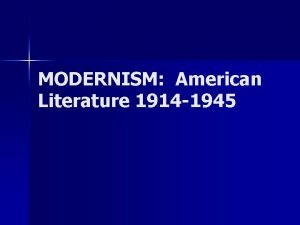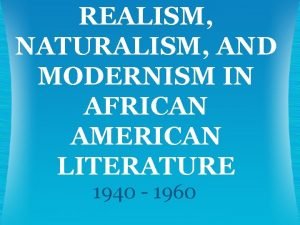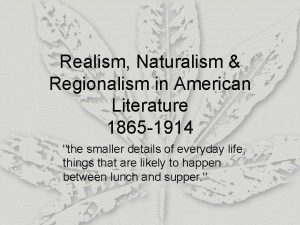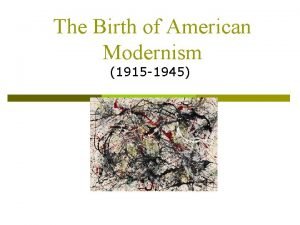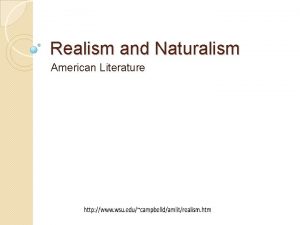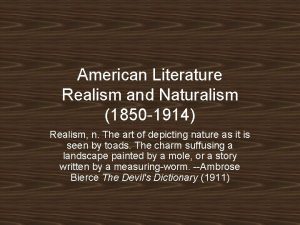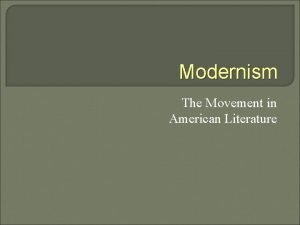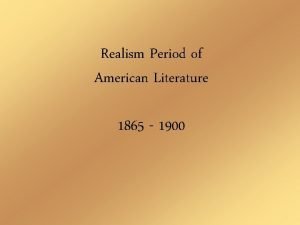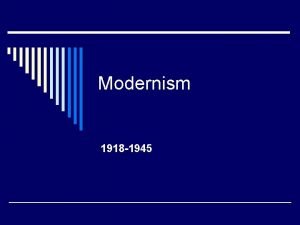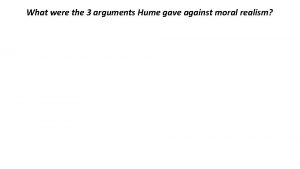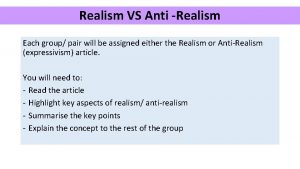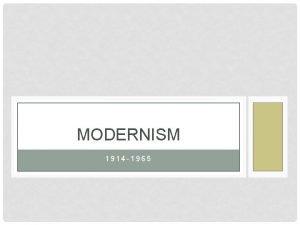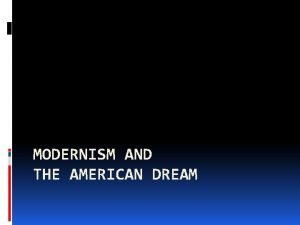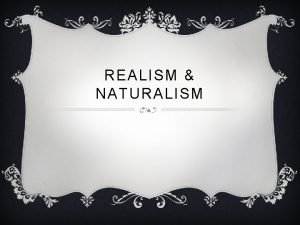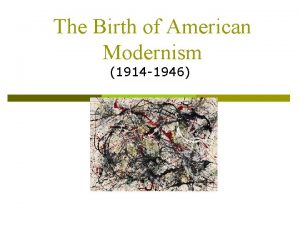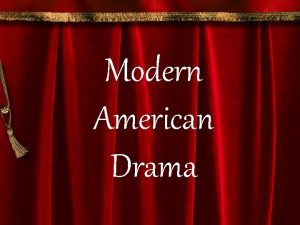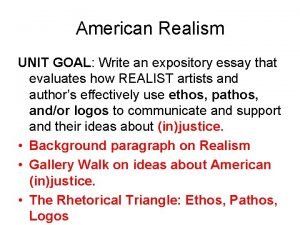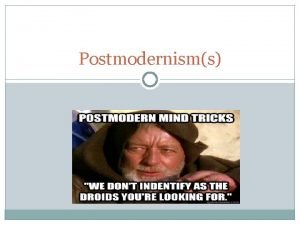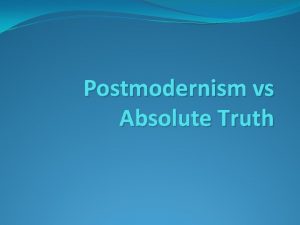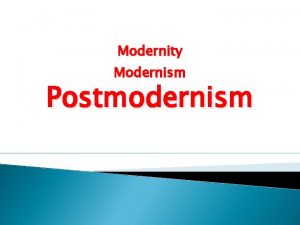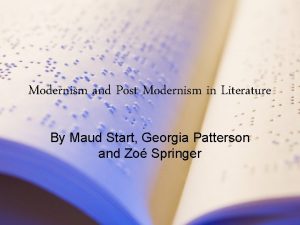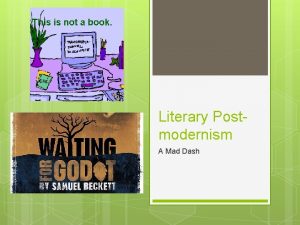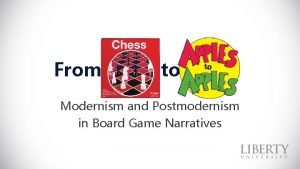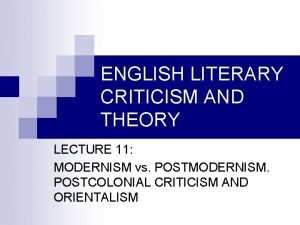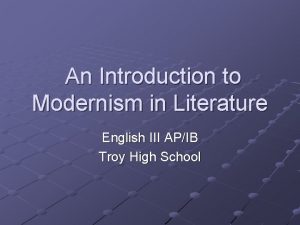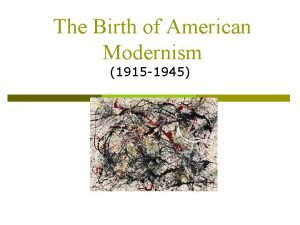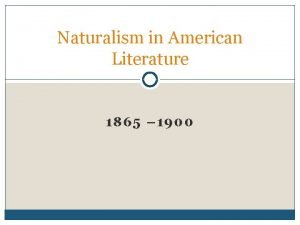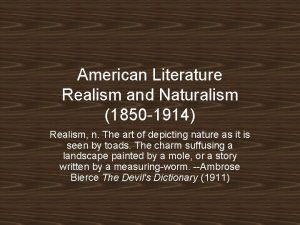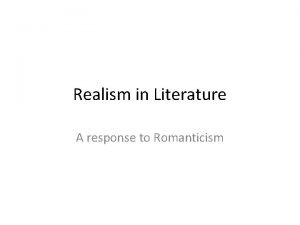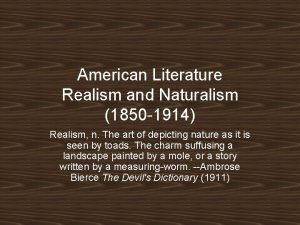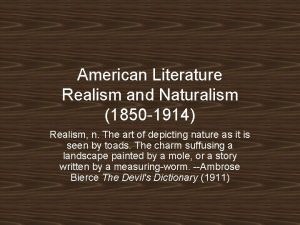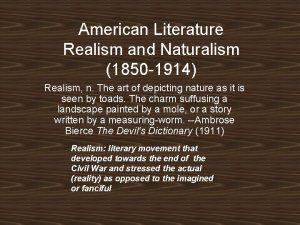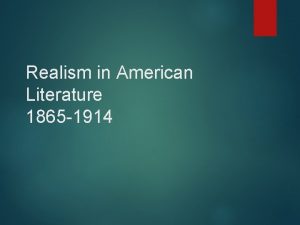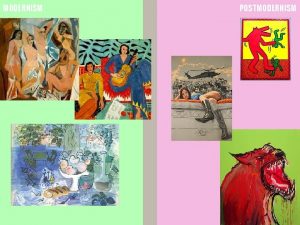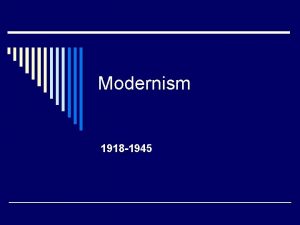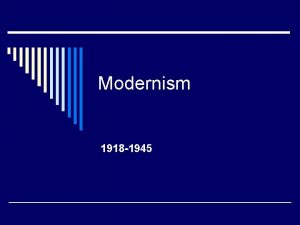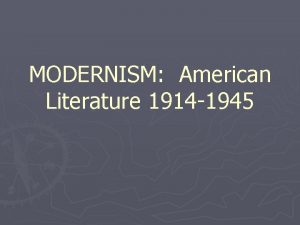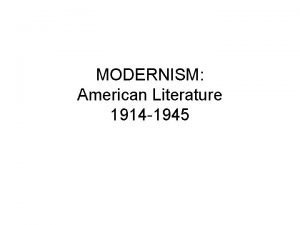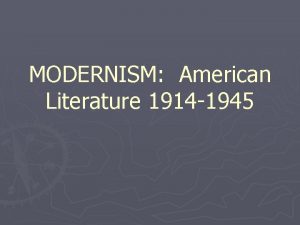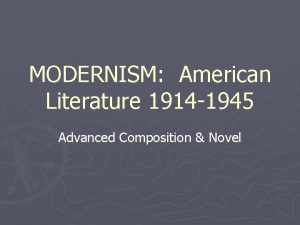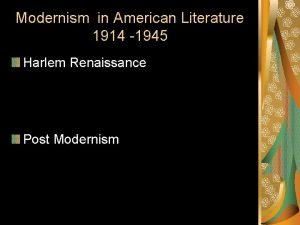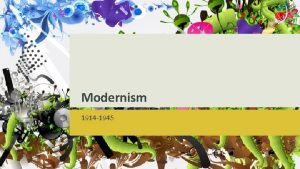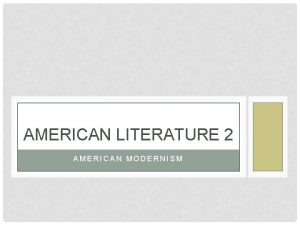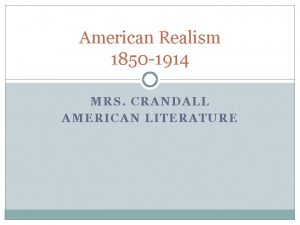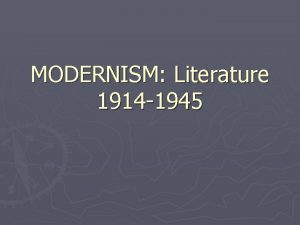MODERNISM American Literature 1914 1945 Realism and Modernism



































- Slides: 35

MODERNISM: American Literature 1914 -1945

Realism and Modernism n Whereas REALISM – Emphasized absolutism – Believed that a single reality could be determined through the observation of nature n n MODERNISM – Argued for cultural relativism – Believed that people make their own meaning in the world MODERNISM Rebelled against nineteenth century academic and historicist traditions “Traditional" forms of art, architecture, literature, religious faith, social organization and daily life: outdated

Causes of the Modernist Temper n n n n WWI (1914 -1919) Urbanization Industrialization Immigration Technological Evolution Growth of Modern Science Influence of Austrian Sigmund Freud (18561939) Influence of German Karl Marx (1818 -1883)

WWI

URBANIZATION

USTRIALIZATION IND

IMMIGRATION Oscar Handlin states, “Once I thought to write a history of the immigrants in America. Then I discovered that the immigrants were American history. ”

TECHNOLOGICAL EVOLUTION

GROWTH OF MODERN SCIENCE Scientists became aware that n n n the atom was not the smallest unit of matter was not indestructible both time and space were relative to an observer’s position some phenomena were so small that attempts at measurement would alter them Some outcomes could be predicted only in terms of statistical probability the universe might be infinite in size and yet infinitely expanding

SIGMUND FREUD (1856 -1939) Invented the use of psychoanalysis as a means to study one’s “unconscious”

KARL MARX (1818 -1883) “The history of all hitherto existing society is the history of class struggles. ” “The development of Modern Industry, therefore, cuts from under its feet the very foundation on which the bourgeoisie produces and appropriates products. What the bourgeoisie therefore produces, above all, are its own gravediggers. Its fall and the victory of the proletariat are equally inevitable. ”

SHIFTS IN THE MODERN NATION from country to city n from farm to factory n from native born to new citizen n introduction to “mass” culture (pop culture) n continual movement n split between science and the literary tradition (“science vs. letters”) n

Social Snapshot of the Times n Result of Political Turmoil – Revolutionary Ideologies Rise n Fascism – The separation and persecution or denial of equality to a certain group based on race, creed, or origin n Nazism – Socialism featuring racism, expansionism and obedience to a strong leader n Communism – Control of the means of production should rest in the hands of the laborers.

Fascism and Nazism

Communism

Modernism Timeline n n n 1914: Outbreak of WWI 1917: US enters war, Russian Revolution 1919: – WWI ends, – Einstein’s Relativity theory confirmed, – Prohibition begins

1920’s: THE JAZZ AGE To F. Scott Fitzgerald it was an “age of miracles, an age of art, an age of excess, an age of satire. ”

Modernism Timeline n 1920 – League of Nations begins; – 19 th Amendment granting women the vote n n n 1921—Irish Free State proclaimed 1922—Fascists march on Rome under Mussolini 1923—Charleston craze

Modernism Timeline n 1925— – Image of human face televised – Hitler published Mein Kampf n 1927 – Lindbergh flies solo across Atlantic – Al Jolson, first talkie

Modernism Timeline n n 1929—US stock market crashes; 1933 – Hitler appointed Chancellor of Germany – First German concentration camps – Prohibition ends in US

1930’s: THE DEPRESSION “True individual freedom cannot exist without economic security and independence. People who are hungry and out of a job are the stuff of which dictatorships are made. ” – Franklin D. Roosevelt

Modernism Timeline n n 1934—Hitler becomes dictator 1936—Civil War in Spain begins 1938—Germany occupies Austria 1939 – Hitler and Stalin make pact; – Germany invades Poland – Great Britain and France declare war on Germany

Modernism Timeline n 1941 – Germany invades USSR – Japan bombs Pearl Harbor, US enters war n 1942 – Battle of Stalingrad, Battle of Midway; – T-shirt invented n 1944—D-Day invasion of France

Modernism Timeline n 1945 – End of war in Europe – Atomic bomb dropped on Japan – First computer built – Microwave oven invented – United Nations founded


Modernist Literature n n The literary form of Modernism and especially High modernism Different from Modern literature: history of the modern novel and modern poetry as one At its height from 1900 to 1940 Authors: – Poems: n n T. S. Eliot – The Waste Land Robert Frost W. B. Yeats Ezra Pound – Short stories and Novels: n n n n n James Joyce William Faulkner Ernest Hemingway – The Old Man and the Sea Franz Kafka Joseph Conrad – The Heart of Darkness Virginia Woolf F. Scott Fitzgerald – The Great Gatsby D. H. Lawrence Katherine Mansfield

CHARACTERISTICS OF MODERNIST WRITING n n n n A movement away from realism into abstractions A deliberate complexity, even to the point of elitism, forcing readers to be very well-educated in order to read these works A high degree of aesthetic self-consciousness Questions of what constitutes the nature of being A breaking with tradition and conventional modes of form, resulting in fragmentation and bold, highly innovative experimentation A variety in content because with a stable external world in question, subjectivity was ever more valued and accepted in literature Along with the social realist and proletarian prose of the 1920 s and 1930 s came a significant outpouring of political and protest poetry.

TECHNIQUES IN MODERNIST WORKS The modernists were highly conscious that they were being modern—that they were “making it new”—and this consciousness is manifest in the modernists’ radical use of a kind of formlessness. n n n Collapsed plots Fragmentary techniques Shifts in perspective, voice, and tone Stream-of-consciousness point of view Associative techniques

COLLAPSED PLOTS n Begins arbitrarily n Advances without explanation n Often ends without resolution n Consists of vivid segments juxtaposed n Is ironic

SHIFTS IN PERSPECTIVE, VOICE, AND TONE n n n representations of the speech of the uneducated and the inarticulate colloquial, slangy, and popular traditional educated literary voice was lost average novel became shorter than it had been in the nineteenth century tends to be written in the first person one character’s point of view

STREAM-OF-CONSCIOUSNESS n Stream-of-consciousness - depicts the mental and emotional reactions of characters to external events, through the practice of reproducing the unedited, continuous sequence of thoughts that run through a person’s head, most usually without punctuation or literary interference.

Stream of Consciousness in E. B. White's "The Door" "Everything (he kept saying) is something it isn't. And everybody is always somewhere else. Maybe it was the city, being in the city, that made him feel how queer everything was and that it was something else. Maybe (he kept thinking) it was the names of the things. The names were tex and frequently koid. Or they were flex and oid or they were duroid (sani) or flexsan (duro), but everything was glass (but not quite glass) and the thing that you touched (the surface, washable, crease-resistant) was rubber, only it wasn't quite rubber and you didn't quite touch it but almost. The wall, which was glass but turned out on being approached not to be a wall, it was something else, it was an opening or doorway--and the doorway (through which he saw himself approaching) turned out to be something else, it was a wall. And what he had eaten not having agreed with him. " (excerpt- "The Door" by E. B. White. The New Yorker, 1939)

Formal Characteristics of Modernist Literature n n n Open Form Discontinuous narrative Juxtaposition – – n Two unlike things are put next to one another A quality of being unexpected To compare/contrast the two Example: A teacup and its saucer are expected Classical allusions – A figure of speech – Making a reference to or representation of, a person, place, event, literary work, myth, or work of art, – Directly or implied

MODERNISM INCLUDES OTHER “ISMS” Fauvism n Cubism n Dadaism n Expressionism n Surrealism n Symbolism n

Works Cited n n Baym, Nina, ed. The Norton Anthology of American Literature. New York: W. W. Norton & Company, Inc. , 1998. Harmon, William, and C. Hugh Homan, eds. A Handbook to Literature. New Jersey: Prentice-Hall, Inc. , 1996. Kimmelman, Burt, ed. The Facts on File Companion to 20 th Century American Poetry. New York: Facts on File, Inc. , 2005. Lathbury, Roger. American Modernism (1910 -1945): American Literature in its Historical, Cultural, and Social Contexts. n Backgrounds to American Literature Series. New York: Facts On File, Inc. , 2006. Siepmann, Katherine Baker, ed. Benét’s Reader’s Encyclopedia. New York: Harper-Collins Publishers, Inc. , 1948.
 Characteristic of modernism from 1914 to 1945
Characteristic of modernism from 1914 to 1945 Realism naturalism modernism
Realism naturalism modernism Regionalism literary movement
Regionalism literary movement Modernism and experimentation in american literature
Modernism and experimentation in american literature Naturalism in literature definition
Naturalism in literature definition Realism
Realism Characteristic of modernism
Characteristic of modernism Realism in american literature
Realism in american literature Realism definition
Realism definition Differences between realism and modernism
Differences between realism and modernism No moral
No moral Normative ethical questions
Normative ethical questions Realism vs anti realism
Realism vs anti realism Modernism and the american dream
Modernism and the american dream Modernism and the american dream
Modernism and the american dream Realism vs naturalism literature
Realism vs naturalism literature Robert wohl
Robert wohl American realism plays
American realism plays American realism essay
American realism essay Modernism vs postmodernism in literature
Modernism vs postmodernism in literature Premodernism
Premodernism Modernism postmodernism timeline
Modernism postmodernism timeline Modernism in literature
Modernism in literature Modern literature definition
Modern literature definition Characteristics of postmodernism
Characteristics of postmodernism Dash in literature
Dash in literature Postmodernism language games
Postmodernism language games Modernism vs postmodernism
Modernism vs postmodernism Introduction to modernism in literature
Introduction to modernism in literature Modernism in literature
Modernism in literature Contemporary realistic fiction vs historical fiction
Contemporary realistic fiction vs historical fiction What is naturalism in american literature
What is naturalism in american literature Characteristics of magic
Characteristics of magic Ecriture naturaliste
Ecriture naturaliste Realism school of thought
Realism school of thought Davis and moore 1945
Davis and moore 1945
